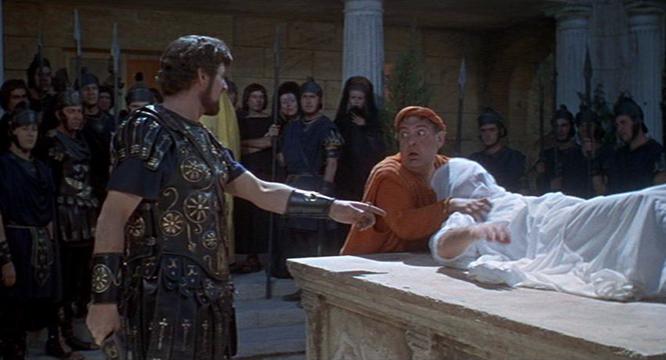The movie 300 directed by Zack Snyder and released in 2006 is a modern sword and sandal film based off of a Frank Miller comic series of 1998 and the ancient Battle of Thermopylae (Kiger). While the action film is not fully historically accurate, it does contain a great deal of legitimate information regarding the Spartan soldiers and their conflicts during that time. The film’s protagonist, Leonidas, a true character, is seen as the leader of the Spartan army throughout the film and is continuously presented to the audience as a man of great courage and loyalty. The film was similar to a lot of our previous movies as it heroically portrayed the protagonist mostly through combat and battle scenes.
https://www.youtube.com/watch?v=uH2M5rh1gvE
In the beginning of the movie Snyder visually shows the audience Leonidas’s background and early life. Leonidas is put to the test at a very young age where he has to pass challenging tests of loyalty and toughness in order to become a Spartan solider. In a History.com magazine titled How Ancient Sparta’s Harsh Military System Trained Boys Into Fierce Warriors, Patrick Kiger, the author, “talks about early Spartan training and how they would begin at the age of seven” (Kiger). The scene begins with the judgment of the boy as a baby seeing if he has the genes accustomed to become a Spartan man (https://www.youtube.com/watch?v=uH2M5rh1gvE). The boy is then put into the Spartan training camp at a young age where he is constantly being tested of his bravery. The clip then ends with the boy taking out a monstrous looking wolf with nothing but a spear in his hand. While this clip above is somewhat accurate it does exaggerate the Spartan training process a bit in order to intrigue the audience. Snyder developed this scene for his movie in order to show where the heroic traits and values Spartan men have stem from, specifically Leonidas’s.
https://www.youtube.com/watch?v=K8B_hLUPhaE
As the movie develops Leonidas seems to only become stronger and more fearless then any Persian man or army. The clip above exhibits one of the battle scene the Spartans have against the Persian army. Snyder begins the scene with a terrifying shake of the earth with the sound and look of an earthquake (https://www.youtube.com/watch?v=K8B_hLUPhaE). Leonidas then reveals that it is the noise of the vast Persian army. Incredibly outnumbered, Leonidas fearlessly smirks seeing the army and prepares his men with a glorifying speech that motivates his men for battle. Snyder uses this scene to show Leonidas’s charismatic side which is something new as we are used to visually seeing him be brave through physical combat. This scene was similar to the speech in the movie Spartacus where the protagonist speaks a phenomenal speech to his army before the time of combat. Similarly, in both scenes the directors focus on the man talking, but also express the army being talked to at the same time which reveals the army’s trust and loyalty towards the speaker.
After two days of holding the army the Spartan Allies began to loose hope as the Persians were gaining ground on them. In Herodotus’s Histories Book 7, Herodotus talks about this time during the battle and says,
“Leonidas himself sent most of his allies away as he worried that all of them might otherwise be killed. But he felt that for himself and the Spartans with him, it would not be decent to leave the post that they had originally come to guard” (7.220).
Knowing his fate, Leonidas courageously sent his allies back to their families and held his ground with his men for Sparta. Herodotus then mentions the history of a “Spartan oracle” and how it says that ” Sparta will be saved if a Spartan King were to die” (7.221). Whether the oracle was true or not Leonidas held his ground for the love of his Country and his people.
The battle scene in the movie ends pretty similarly to the historical account Herodotus mentions in his work. Hit with arrows and scraped up Leonidas is still seen fighting courageously using all of the energy he has left. Leonidas dies a very heroic and glorious death in the movie where he is seen as the last Spartan standing fearing nothing but the powerful will of himself. Snyder portrays Leonidas’s death as he the leader is seen dead with all of his soldiers laying in the middle of all of them visually expressing his rank as their ruler.
From the Birth of King Leonidas all the way to his glorious death Snyder expresses extreme loyalty and traits of heroism within the character. Through scenes of combat and violence, and through scenes of speeches and charisma, Snyder attracts the audience to this character of power and courage. Seen not only in the movie, but heard from the ancient writing’s of Herodotus, Leonidas is known to be a man of great strength and bravery.
Works Cited
Herodotus. Herodotus (Book 7) : the Histories. London, Eng. ; New York :Penguin Books, 1996.
Kiger, Patrick J. “How Sparta Used Harsh Training to Produce ‘Perfect’ Warriors.” History.com. A&E Television Networks, September 8, 2020. https://www.history.com/news/sparta-warriors-training.
LeeMajors. “300 Final Battle Scene.” Youtube, 5 Oct. 2013, https://www.youtube.com/watch?v=K8B_hLUPhaE
Snyder, Zack. “300 The Movie.” Flickr. Yahoo!, March 9, 2008. https://www.flickr.com/photos/lifes__too_short__to__drink__cheap__wine/2321195425.
SpartaChannel. “Leonidas was a Kid.” Youtube, 11 Mar. 2017, https://www.youtube.com/watch?v=uH2M5rh1gvE

